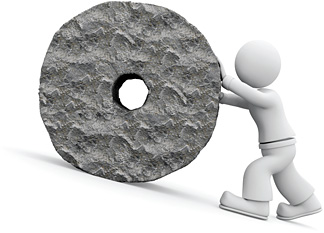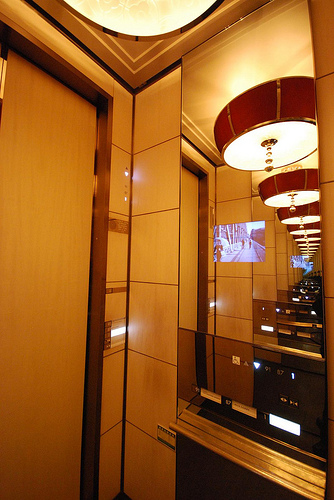by blogmistress on August 17, 2011
You can’t just ask customers what they want and then try to give that to them.
By the time you get it built, they’ll want something new.
STEVE JOBS CEO, APPLE
Have you ever done that? I know I have. That is one of the things I love about Apple. They not only give us what they think we want, they think ahead to what we may want or need in the future.
Being innovative and delivering to customers products and services that they will love takes a lot of communication. I have learned the lesson that Steve Jobs speaks of the hard way (maybe he did to). I think there are two things that can help us avoid this situation:
- Confidence – You are an expert in your field as I am an expert in my field. Sometimes, what our customers want is not what would be the best for them. They may not be aware of everything that is available to them or the problems associated with what they desire. As an expert in your field, you (and I) need to address possibilities and problems confidently and knowledgeably.
- Communication – We need to constantly be asking questions and learning what our market needs, thinking about what will help them now and in the future. We need to be sure to stay in constant communication with the people we help, and the ones we can help, to know what problems they face and how we can solve those problems.
It is always a good idea to give customers what they want, we just need to keep in mind that what they want and what they need changes. What are you doing to deliver the best to your customers today?

by Admin on August 11, 2011
 How many of you have a website for your business that requires you to call up your web designer or IT person every time you want to make any change to your website? If you do, this is akin to requiring an employee or vendor to meet you every morning to let you into you business and paying them to do it.
How many of you have a website for your business that requires you to call up your web designer or IT person every time you want to make any change to your website? If you do, this is akin to requiring an employee or vendor to meet you every morning to let you into you business and paying them to do it.
A few years ago we started using a content management system (CMS) for all of our websites. With a CMS, a client can do anything from correcting a misspelled word to creating an entirely new page. They can make the changes they are comfortable in making. Sure, they can still call us to do anything they don’t feel comfortable doing; and for some, that’s most everything. But the choice is theirs. They are in control.
Last year, Marcus Sheridan said in his blog The Sales Lion that you have lost control of your business if you answer ‘NO’ to any of the following questions:
- Could you tell me within the next 30 seconds how many visitors (customers) your website had today?
- If you noticed a typo in some text on your website, could you change it immediately?
- If you needed to make a company announcement on your site that was time sensitive, could you do so within the next few minutes?
- If you wanted to add an amazing photo to your website of some work your company just completed, could you show it now?
- And finally, if you wanted to add a video of a customer testimonial you just made (with your cool little flip camera) to the ‘testimonial page’ on your website, could that happen right away?
He says over 90% of small business owners have to contact their webmaster to do what a 6 year old could do with the right tools. And not only do they often have to wait days for their changes to be made, they’re getting charged for it. With the right CMS, you could answer “Yes” to every question in the list.
Get The Right CMS
We suggest using an “Open Source” CMS. These are usually free, so there is no special software you have to buy to use them. Three of the oldest and most popular Open Source CMSs are: Drupal, Joomla and WordPress. There are some new up and comers that are also good. One good thing about these CMS platforms is that they each have a large community of designers that use them. Therefore, if you decide to leave your current web designer, for whatever reason, you should have no trouble finding a replacement.
Beware of the proprietary CMS. Many website designers and developers have created their own Content Management Systems. The problems with these are:
- They may not be as secure because the developer doesn’t have the resources to test it as well as an Open Source Community
- It may cost quite a bit to get a special feature implemented
- Only that particular design company has the right to use the CMS, so if you leave them, you have to start all over
Do you have the keys to your business? If not, call us and let us make you a set of your own keys.

by Admin on August 5, 2011
I mentioned on Wednesday a website where the menu items were hidden behind objects on the home page. Another more prevalent poor website navigation technique used is one where the layout of every page is different.
You’ve seen the websites. The home page has a horizontal menu across the top. The About page has a vertical menu down the left side. The Contact page has both horizontal and vertical menus. The rest of the site has a horizontal menu but the menu items are ordered differently on every page.
I’ve also seen websites where only the Home page has a menu. Every page is linked from the Home page, but the only link on the other pages is one that says “Return to Home Page”. That’s akin to being required to return to the Table of Contents in a book after completing each before proceeding to the next chapter. What’s up with that?
As I said on Wednesday, studies have shown that one of the most important elements of a website is how easy it is for a website visitor to find what she is looking for. And a key part of this is a logical and consistent navigation system. This requires planning by the website designer. You need to have a plan as to how new pages will be added to the menu. You don’t want to have to completely restructure your menu system every few months because you didn’t plan on having new pages to go on the menu.
What is your navigation system plan for your website?
by Admin on August 3, 2011
Have you ever been to a website where you had to hunt for the menu items? I was at such a website the other day. It was a very aesthetically pleasing site, but totally dysfunctional. The menu items were hidden in objects around the site, but you didn’t know an object was a menu item until you rolled the cursor over it.
We’ve had clients come to us and say they want a website that is different and fun. We love being creative. However, while being creative, you must keep in mind that a website must be functional first. You can use some different and fun elements on the site, but the site must be functional. Studies have shown that while people may initially be intrigued by a site that is different, whether they will actually use that site depends upon how easily they can find what they are looking for.
The reason most websites are set up similarly (i.e. a header at the top, a menu at the top or on the side and content below or next to the menu) is the same reason that books are similar (i.e. a cover with the title, a table of contents, the contents on numbered pages in numerical order and an index, all bound together). How many of you would buy a book that had a beautiful cover but the table of contents, pages and index were all out of order?
The point is don’t get caught up in design that is too clever by half. Unless you are a graphic designer or computer programmer, your website visitors are not coming to your website to see those skills on display. Clever gimmicks only distract from your message and make it harder for website visitors to find what they are looking for.
When it comes to website design be creative, be remarkable, but always, be easy to use!

by blogmistress on August 2, 2011
 How about that? When you are looking for something online, you find it. That is the simplest, most direct and best website strategy there is. As Seth Godin says, “Many websites say, ‘look at me.’ Your goal ought to be to say, ‘here’s what you were looking for’.”
How about that? When you are looking for something online, you find it. That is the simplest, most direct and best website strategy there is. As Seth Godin says, “Many websites say, ‘look at me.’ Your goal ought to be to say, ‘here’s what you were looking for’.”
It really is that simple. When someone finds your business online, it is usually because they were looking for you. Give them what they were looking for! Make your information easy to understand. Make it easy to navigate. Make it attractive. Make it easy to convert by including compelling calls to action. Use a blog to incorporate fresh, interesting, up to date information.
Measure your results. See what is working and what is not working. Get rid of what is not working and improve what is working to make it better.
Don’t try to reinvent the wheel here. What works, works. Do what works.
“We need to stop interrupting what people are interested in & be what people are interested in.”
~Craig Davis CCO, Worldwide
J. Walter Thompson (world’s 4th largest ad agency)

by blogmistress on July 29, 2011
Does your business stay the same day in and day out. For most of us, the answer is no. Sure there are some constants such as our phone number and address and main products and services. However, if we never change anything or offer anything new or do something different, we are pretty boring. The same is true for your website. If you put up a website and never change anything, it is pretty boring.
Static, brochure style websites can certainly serve a purpose. They can let people know about you, where you are located, how to reach you and about your products and services. That is what it should do. But, that by itself, is just a little boring. It is also a little boring to search engines as well.
Why not update your site and offer fresh information on a regular basis? You know where this is going, don’t you? Here it is, the easiest, most effective way to regularly offer fresh, up to date information is with . . . a blog. I know you have heard me say this a thousand times, but until something else comes along that is better, I’ll stick by this. I’ll also restate the stats that back me up. Companies that blog get:
- 55% more visitors
- convert 40% more of their visitors into leads
- have 434% more indexed pages
- get 97% more inbound links
I’ve even seen businesses that don’t blog very often or blog very inconsistently benefit from a blog. It takes them a lot longer, but they still benefit. Does your business have a blog? Tell me about it and get a free blog analysis.
by blogmistress on July 27, 2011
We are always stressing the importance of optimizing pictures for load speed to all of our website clients as well as our blogging clients. Yes, it is an extra step, and, yes, it takes a little bit more time, but it is a very important step. Why? Because it makes your page load faster which is good for visitors whether they be web spiders or real live people. Optimizing pictures is just one way to speed up page load, but it is also one of the easiest. Google thinks speed is so important, they created a “Make the Web Faster” program and have built tools to help you evaluate the load time of your page and increase the speed.
Sometimes, people get the mistaken idea that optimizing pictures for the web will greatly diminish the quality of the pictures. Let’s look at an example:

Picture 1

Picture 2
Which picture do you think is optimized? The answer is picture 2. There is a slight difference in quality, however, picture one will load much slower. Is there enough difference in the pictures that you would turn off your website visitors with slow pictures just to get that very small amount of extra quality. Actually, I saved the 2nd picture using a medium quality. It could have been saved as high quality and it would have looked even better and, yet, still be optimized. I did this just to show the difference. The picture size is the same, but the file size of the 2nd picture is smaller so, it will load faster. Picture 1 is 291kb, Picture 2 is 29kb.
So, how can you optimize you pictures for speed? You can use tools such as PhotoShop Elements that have a picture optimizer included. This program costs around $80. It is also good for editing pictures for quality. Some versions of Windows include a photo program that you can use to compress file sizes of pictures. If you don’t have a tool available to you for compressing pictures, you can use a free online tool such as the image optimizer at imageoptimizer.net.
Don’t keep your website or blog visitors waiting on slow loading pictures. Oh, and by the way, many of your visitors may now be visiting you on their mobile devise and they definitely don’t want to be kept waiting! Optimize your pictures and help make the web faster.

by Admin on July 26, 2011
 We are often asked by people who have had a website redesign why their customers see a 404 Page Not Found error when trying to access their website. We have to tell them that the person who did their website redesign did not implement 301 redirects.
We are often asked by people who have had a website redesign why their customers see a 404 Page Not Found error when trying to access their website. We have to tell them that the person who did their website redesign did not implement 301 redirects.
For those who don’t know, a 301 Redirect is a web server function where an old URL is redirected to a new one. A 301 Redirect is a “permanent” redirect status indicating that the resource has moved permanently. A 301 Redirect tells a browser that a webpage that was located at yoursite.com/a is now located at yoursite.com/b.
Often when websites are redesigned, the URL’s of some or all of the website’s pages change. This could be due to a change from an html system to a content management system or any of a number of reasons. When this happens, you need to use a 301 Redirect for a couple of reasons: 1) the old URL may have some Google juice (i.e. it may rank for certain terms) and you don’t want to lose that, and 2) there may be links to the old URL and you don’t want to lose those either.
By using 301 Redirects, you let Google and web browsers know that a page has moved to a new URL. That way the new page will be delivered when searched for or linked to; otherwise, the web browser would display a 404 Page Not Found Error. It is very important for maintaining a website’s search engine optimization.
Many web designers either don’t know the importance of 301 Redirects in website redesigns or just don’t include them. Be sure to ask your website designer if she will be including 301 Redirects with her redesign of your website. If not, you may want to consider a different website designer.
(Note: URL = the www.yoursiteaddress.com)
by blogmistress on July 25, 2011
 What do mirrors have to do with website strategy? You’ve probably heard the story about why many tall buildings have mirrors near the elevators. The story goes that at one building, people often complained about the waiting time for elevators. They maintained that the elevators were just too slow. The people who managed the tall building called in engineers and gave them the challenge of fixing the problem. They came up with ideas for speeding up the elevators, but all of the solutions were too costly and inefficient.
What do mirrors have to do with website strategy? You’ve probably heard the story about why many tall buildings have mirrors near the elevators. The story goes that at one building, people often complained about the waiting time for elevators. They maintained that the elevators were just too slow. The people who managed the tall building called in engineers and gave them the challenge of fixing the problem. They came up with ideas for speeding up the elevators, but all of the solutions were too costly and inefficient.
One of the persons who studied the problem determined that the elevators were not too slow, the people were just bored while they were waiting for the elevator and became impatient. He suggested that the solution was not to make the elevator go faster, but to distract the people who were waiting for the elevator. They put up mirrors by the elevators, and it worked! People were distracted by seeing themselves (and others) in the mirrors and no longer complained about the slow elevators.
What happened in the story is that the solution was found by finding out what motivated the user. We should do the same when we are building websites or any type of internet presence. Too often as business owners and web designers, we focus on the product or service that is being offered instead of the user experience for our customers or potential customers. Studies show that what people want most from any website is to be able to easily find what they want. They care about that more than design or color or anything else. While they may be initially impressed by the aesthetic beauty of a website’s design, the real test comes in its usability (i.e. how quickly they can find what they are searching for).
Always keep in mind that when someone visits your website, they came to you because they were looking for something specific. They usually typed words into a search engine, you came up and they land on your site. Now is the time to give them what they are looking for. Think about what motivates the end user. In website design, we don’t want to distract our users with mirrors (or anything else). The internet world is not known for its patience. Things that load slowly or flash are distracting from what they really came for, what they were looking for when they found you. If people who come to your website don’t quickly see what they are looking for, they leave. Just like the elevator story, the best and simplest solution is found when you look to the end user and satisfy them.

by blogmistress on July 20, 2011
 Yesterday, Apple released a quarterly sales report. iPhone sales were up 142% year over year and according to the report, “91% of Fortune 500 are using or testing the iPhone as a primary device, including major corporations like Nestle, Dow Chemical, Glaxo Smith Kline, and Comcast. In addition, 57% of all Fortune 500 are similarly deploying or testing the iPhone.” Apple continued to sell every single iPad they could build.
Yesterday, Apple released a quarterly sales report. iPhone sales were up 142% year over year and according to the report, “91% of Fortune 500 are using or testing the iPhone as a primary device, including major corporations like Nestle, Dow Chemical, Glaxo Smith Kline, and Comcast. In addition, 57% of all Fortune 500 are similarly deploying or testing the iPhone.” Apple continued to sell every single iPad they could build.
This is just the Apple report. If you were to add sales of other smart phones and tablets to this report, you can see that smart phones and tablets are a hot market. That means as businesses that market to the smart phone and tablet users, we have to adapt. Some tips for making your site mobile friendly seem to be in order:
- Automatically detect mobile. Mainstream dynamic, database driven content management systems (CMS) such as WordPress have plugins that can do this for you. If you are still using a static HTML type of site, you can use user agent detection. Use cascading style sheets (CSS) to render the mobile version of your site when a mobile browser is detected.
- Get rid of Flash and Flash elements. Even though Flash elements will show up on non iPhone types of devices, they are still not mobile friendly. They tend to be resource hogs that can slow things down and eat up memory. Of course, they are not friendly at all for iPhone devices. Apple made the decision to not render Flash because it does eat up resources. Not rendering Flash makes the smart phone battery last longer and makes the use of the smart phone more efficient.
- Optimize your pictures to make them load fast. You can use photo editing programs to shrink the file size of your photos so they will load faster. If you don’t have a photo editing program that will do this for you, you can use free online programs like imageoptimzer.net. Mobile users tend to have short attention spans. Don’t make them wait for picture loads! This is a good tip for your desktop site as well.
- Rethink your navigation. If you have header, footer and sidebar links that may not be high priority links for your mobile users, remove them for your mobile version. Mobile users often come to your site to look at one page, perhaps to get a phone number or map. Make your navigation simple and lean.
- Give mobile users a clear way to get to the full site. Occasionally, visitors may be looking for something that is not included on your mobile site, for those users, a path to the full site is helpful. Make sure that your full site is also simple to navigate and loads as quickly as possible as well.
Mobile has become a major part of the web instead of a small niche market. Make sure that you address those users. Measure your results to see where your visitors are coming from, what devices they are using and what types of content they are looking for, and adjust. Your full site users and your mobile users may be looking for different types of content. Find out what they are looking for and deliver!


 How many of you have a website for your business that requires you to call up your web designer or IT person every time you want to make any change to your website? If you do, this is akin to requiring an employee or vendor to meet you every morning to let you into you business and paying them to do it.
How many of you have a website for your business that requires you to call up your web designer or IT person every time you want to make any change to your website? If you do, this is akin to requiring an employee or vendor to meet you every morning to let you into you business and paying them to do it.
 How about that? When you are looking for something online, you find it. That is the simplest, most direct and best website strategy there is. As Seth Godin says, “Many websites say, ‘look at me.’ Your goal ought to be to say, ‘here’s what you were looking for’.”
How about that? When you are looking for something online, you find it. That is the simplest, most direct and best website strategy there is. As Seth Godin says, “Many websites say, ‘look at me.’ Your goal ought to be to say, ‘here’s what you were looking for’.”


 We are often asked by people who have had a website redesign why their customers see a 404 Page Not Found error when trying to access their website. We have to tell them that the person who did their website redesign did not implement 301 redirects.
We are often asked by people who have had a website redesign why their customers see a 404 Page Not Found error when trying to access their website. We have to tell them that the person who did their website redesign did not implement 301 redirects. What do mirrors have to do with website strategy? You’ve probably heard the story about why many tall buildings have mirrors near the elevators. The story goes that at one building, people often complained about the waiting time for elevators. They maintained that the elevators were just too slow. The people who managed the tall building called in engineers and gave them the challenge of fixing the problem. They came up with ideas for speeding up the elevators, but all of the solutions were too costly and inefficient.
What do mirrors have to do with website strategy? You’ve probably heard the story about why many tall buildings have mirrors near the elevators. The story goes that at one building, people often complained about the waiting time for elevators. They maintained that the elevators were just too slow. The people who managed the tall building called in engineers and gave them the challenge of fixing the problem. They came up with ideas for speeding up the elevators, but all of the solutions were too costly and inefficient. Yesterday, Apple released a quarterly sales report. iPhone sales were up 142% year over year and according to the report, “91% of Fortune 500 are using or testing the iPhone as a primary device, including major corporations like Nestle, Dow Chemical, Glaxo Smith Kline, and Comcast. In addition, 57% of all Fortune 500 are similarly deploying or testing the iPhone.” Apple continued to sell every single iPad they could build.
Yesterday, Apple released a quarterly sales report. iPhone sales were up 142% year over year and according to the report, “91% of Fortune 500 are using or testing the iPhone as a primary device, including major corporations like Nestle, Dow Chemical, Glaxo Smith Kline, and Comcast. In addition, 57% of all Fortune 500 are similarly deploying or testing the iPhone.” Apple continued to sell every single iPad they could build.